Calamophyton
| Calamophyton | ||||||||||||
|---|---|---|---|---|---|---|---|---|---|---|---|---|

Calamophyton |
||||||||||||
| Temporal occurrence | ||||||||||||
| Middle Devon | ||||||||||||
| Systematics | ||||||||||||
|
||||||||||||
| Scientific name | ||||||||||||
| Calamophyton | ||||||||||||
| Krausel & Weyland |
Calamophyton is an extinct, a few decimeter high plant with dichotomous branches. It belongs to the group of the Pseudosporochnales standingnear the base of the ferns .
features
Calamophyton was at least two feet tall.
Calamophyton primaevum , originally described from the Central Devonian of Germany, was reconstructed as a 35 cm high plant with a finger-like branched main axis, on which there are segmented leaves in a helical arrangement. The short, dichotomously branched branches carry a single sporangium at each end . In cross-section it shows a variable number of xylem arms , ranging from 10 to 33. There were fewer xylem arms in the upper part of the plant. The xylem strands are radially elongated in cross section. There are bundles of fibers in the base of the trunk.
Calamophyton bicephalum from the Middle Devon has a central axis with finger-shaped side branches. The side branches have a diameter of around 1 cm and branch dichotomously. In cross-section, the axis has 14 to 16 vessel segments which are either oval or have 4 to 5 radial arms. There is only primary xylem.
The sterile, terminal appendages become smaller and less well developed from bottom to top. The leaves are three-dimensional structures, each dividing dichotomously horizontally and vertically. Young leaves in the distal part of the plant fork only once, while those in the lower part fork up to four times.
There is evidence that leaves and sporangia were on different branches. The sporangia are not united into cones. The sporangular branches are opposite along the fertile axis in a pseudo-whorled arrangement. Sometimes sporangular branches stand between sterile whorls . Each fertile branch consists of a basal stalk that is divided into an upper and a lower segment. Each segment is further divided into three short side branches, each ending in a short fork with a single sporangium at each end. Thus, in Calamophyton bicephalum, each branch bears 12 sporangia. The sporangia are cylindrical and pointed at the end. They should have opened on the ventral side (underside). The spores of Calamophyton bicephalum range in size from 86 to 166 µm. Each spore is circular in outline and has a distinct trilete (three-rayed) scar, with delicate spines on the surface.
The finds that were initially described as Hyenia are now also included in the genus Calamophyton . The finds, originally interpreted as rhizomes , are now interpreted as a series of side branches. From the branches branch off dichotomously branched appendages, each of which has three pairs of elongated sporangia. The sporangia open with a longitudinal slit, the spores are large and triple. The sterile appendages are three-dimensional structures that fork dichotomously several times.
A specimen of Hyenia elegans , which Schweitzer described in 1972, consists of a rhizome almost 2 m long and 4.4 cm in diameter. There are side branches on it in a spiral arrangement, which branch dichotomously.
Systematics and botanical history
Today is Calamophyton the basis of the axis Anatomy pseudosporochnales asked. Originally, a distinction was made between several genera or species, which according to the work of Farin-Demaret and Berry (2000) all belong to Calamophyton primaevum . Some authors further differentiate between Calamophyton primaevum and Calamophyton bicephalum .
Calamophyton and Hyenia , both from Devonian, were placed in the group of Protoarticulatae (= Hyeniales) by Kräusel and Weyland in 1926 , a group of Devonian herbaceous plants that is now obsolete and whose characteristics are similar to the Sphenophyta . They were branched as dichotomous and interpreted as emerging from a rhizome . The last branches had sterile appendages in pseudo whorls. Sporangia are on modified branches. The Hyeniales should represent an evolutionary parallel development to the Devonian lycophytes , such as the Drepanophycales and Protolepidodendrales .
Finding fossilized axes of Calamophyton (Leclercq and Schweitzer 1965, Schweitzer 1972, 1973) made it clear that this genus has a unique anatomy that in no way resembles the Sphenophyta.
Hyenia elegans as well as Cladoxylon scoparium are now included in the species concept of Calamophyton primaevum . Since all three types of Krausel and Weyland were first described in the same publication in 1926 , the question of the valid name is complex. Fairon-Demaret and Berry suggested Calamophyton primaevum for the following reasons: the type material from Hyenia from Norway could not be assessed and the anatomy does not fit into the generic concept of Cladoxylon , especially since all other types of Cladoxylon come from the Mississippium .
supporting documents
- Thomas N. Taylor, Edith L. Taylor, Michael Krings: Paleobotany. The Biology and Evolution of Fossil Plants . Second Edition, Academic Press 2009, ISBN 978-0-12-373972-8 , pp. 396-398.